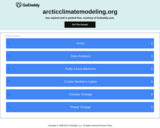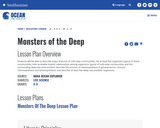
In this lesson, students diagram the flow of energy through living systems, including food chains, food webs, and energy pyramids.
- Subject:
- Science
- Material Type:
- Lesson Plan
- Provider:
- Texas Gateway for Online Resources
- Date Added:
- 03/29/2017

In this lesson, students diagram the flow of energy through living systems, including food chains, food webs, and energy pyramids.

Students will read scientific text about top predators in Arctic marine ecosystems and how they may be affected by global climate change. Students will work individually or collaboratively to write a report based on the scientific text they have read and participate in a large-group discussion session based on their analysis.

This lesson will incorporate how organisms affected at one trophic level in an ecosystem can change the entire structure of the ecosystem. The students will gain an understanding that human impact through deforestation, climate change and even restoration effort can alter an ecosystem's flow of energy through a food web which can have a chain effect spreading through the entire food web. The affect could cause an entire ecosystem to collapse especially if the original organism affected is a keystone species or an umbrella species. Students will learn that the extinction of the polar bears will cause devastation on the Arctic ecosystem that may cause the extinction of world biome.This lesson was developed by Elizabeth Bartlett as part of their completion of the North Carolina Global Educator Digital Badge program. This lesson plan has been vetted at the local and state level for standards alignment, Global Education focus, and content accuracy.

Students will investigate an ecosystem of their choice and then create a food web poster with at least 30 organisms. The students will have different sections that will include food web, food chain, energy pyramid, invasive species, and symbiosis, climate and population factors within an ecosystem. This is the summative lesson of the unit. This will allow the student to apply all the information that has been learned throughout the unit. The students will demonstrate through analyzes how an ecosystem is an interconnected ever changing system that incorporates many factors that affect organisms living in the ecosystem.This lesson was developed by Elizabeth Bartlett as part of their completion of the North Carolina Global Educator Digital Badge program. This lesson plan has been vetted at the local and state level for standards alignment, Global Education focus, and content accuracy.

Lesson one allows students to explore the interconnection between organisms and the environments they make their homes. They will begin with investigating how food webs, food chains and energy pyramids are different and similar throughout the world. By analyzing food webs, food chains, and energy pyramids, the students will be able to discover how different organisms in different ecosystems throughout the world utilize each other for their own survival. This lesson specifically addresses the need for students to understand how organisms within an ecosystem interact with each other. It will include the interaction of producers, consumers, and decomposers as energy flows through the ecosystem.This lesson was developed by Elizabeth Bartlett as part of their completion of the North Carolina Global Educator Digital Badge program. This lesson plan has been vetted at the local and state level for standards alignment, Global Education focus, and content accuracy.

This lesson provides students with an opportunity to explore the climate change concept in greater depth. The focus is on plant competition, reproductive output, and how these concepts may vary based on climate change predictions. The emphasis in this lesson is the effect of increasing amounts of water, predicted by global climate change models for some parts of the United States, on the production of fruits and seeds (measures of reproductive output).

This brief video lesson edxamines the many ways in which energy cycles through our planet, from the sun to our food chain to electricity and beyond. Discussion/assessment questions and suggested supplemental resources are also included.

Students explore interactives to learn about hydrothermal vent chemistry and the animals that have adapted to living in the harsh environment near vents.

Students will make a food diagram of the hydrothermal vent community and show the flow of energy and materials in this ecosystem.

Students will use questions they develop regarding water and the local ecosystem to design and perfom an original ecohydrology experiment. The results of their independent study and background research will be communicated in a written paper which encompasses all the steps of the scientific method.

In this lesson, students learn about the carbon cycle and how carbon dioxide enters the atmosphere.

This lesson focuses on how marine-derived nutrients from salmon carcasses find their way into terrestrial environments and how scientists can track these marine-derived nutrients to analyze their importance to ecosystems today, as well as, reconstructing past ecosystem processes. After learning about salmon nutrient cycling, students will complete a food web simulation activity. Students will complete a bioaccumulation quiz as a summary assignment for the lesson. The presentation needed for the lesson can be downloaded from: https://www.nps.gov/_cs_upload/olym/learn/education/classrooms/601617_1.pptx

Students will learn about deep-sea tubeworms. Students will work collaboratively to create a poster or three-dimensional model of a tubeworm. Each group will then prepare a written report describing the anatomy of tubeworms, how a tubeworm obtains food and the symbiotic relationship between the tubeworm and chemosynthetic bacteria, and the role that tubeworms play in the larger cold-seep food web.

In this series of activities, students will design and build models of nine life support systems which are crucial to a successful settlement of the Moon. They will make plans based on their knowledge of how these systems work on Earth.

This online resource provides information and images that cover the major cycles of the earth system (energy, water, atmosphere, carbon, nitrogen, and rock cycles).

Students use marine organism cards and trophic level classifications to identify and describe food chains in several marine ecosystems.

Students investigate marine food webs and trophic levels, research one marine organism, this activity sand fit their organisms together in a class-created food web showing a balanced marine ecosystem.

Students explore the role of soil microbes in the carbon cycle and investigate how quickly different kinds of paper decompose under the action of soil microbes.

Students will be able to describe major features of cold seep communities; list at least five organisms typical of these communities; infer probable trophic relationships among organisms typical of cold-seep communities and the surrounding deep-sea environment; describe the process of chemosynthesis in general terms; contrast chemosynthesis and photosynthesis; and describe at least five deep-sea predator organisms. Students will work in collaborative groups to research the ecology of cold seep communities and orally present their findings to the rest of the class. The teacher will also lead an effort to create a food web showing the ecological relationships of these communities.

This tutorial describes how the composition of the atmosphere of Earth has changed over time.